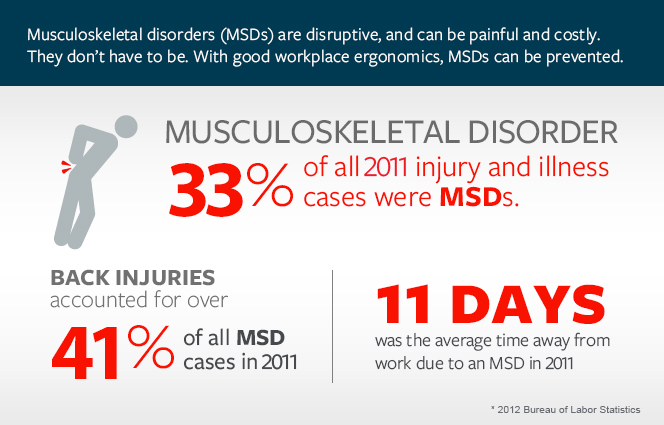Guide to Ergonomics in the Workplace

Effective and successful workplace ergonomics involves the application of basic workplace principles to help address a worker’s discomfort, chronic pain or injury. A large part of good ergonomics involves workstation arrangement, equipment orientation and employee work habits. Proper placement of workstation equipment helps, but good ergonomics starts with the selection of furniture that can be easily adjusted to meet the needs of varied employees.
Having an effective ergonomics process can help you identify those job tasks and workplace factors that can put employees at risk of developing musculoskeletal disorders (MSDs). These types of conditions can result in additional expenses and lost productivity for your company. Addressing the risks should be a business imperative. Establishing a good ergonomics process can help reduce the frequency of MSDs, address ergonomic risk factors and concerns, and control workers compensation costs.

Musculoskeletal disorders (MSDs) are disruptive, and can be painful and costly.
They don't have to be. With good workplace ergonomics, MSDs can be prevented.
MUSCULOSKELETAL DISORDER
33% of all 2011 injury and illness cases were MSDs.
BACK INJURIES
accounted for over 41% of all MSD cases in 2011
11 DAYS
was the average time away from work due to an MSD in 2011
Some areas to consider in minimizing the risk of MSDs include:
- Good workstation chairs.
- Proper keyboard and mouse placement.
- Correct monitor/reference material positioning.
- Sufficient lighting to help reduce eyestrain.
Good work habits are essential to avoiding injuries from computer use. Even with the best workstation and properly positioned equipment, employees could end up with discomfort or MSDs. Your employees may develop bad habits over time that can lead to the development of MSDs.
Good habits to promote include, but are not limited to:
- Change your work position, chair height and angle, and keyboard position throughout the day.
- Look away from the screen periodically to focus on distant objects.
- Use the "ALT" functions on your keyboard where possible to reduce mouse use.
- Hold the phone with your non-writing hand or use a headset. Do not hold the phone with your chin and shoulder as this can lead to neck tension, headaches and pinched nerves.
- Stand to reach items on shelves above your desk, rather than reaching from your chair.
- Squat or go to one knee while getting materials from bottom drawers or shelves.
Changing work habits takes time and dedication. Even a slight keyboard height change can initially feel awkward. If a change feels awkward, work using the modified arrangement for at least a week to give it a chance to become natural.
Armed with this information, you can increase employee safety and comfort through education and workstation modifications, rather than making costly furniture or equipment purchases.



